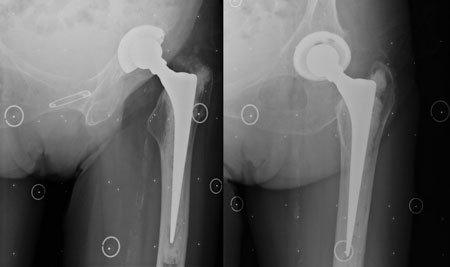Long-term study reveals lower steady state wear with highly crosslinked polyethylene liners
SAN FRANCISCO — After an initial period of rapid penetration in the first year, investigators of a level 1 study using radiostereometric analysis found a significantly lower steady state wear rate during 10-year follow-up among total hip arthroplasties performed with highly crosslinked polyethylene liners compared to conventional polyethylene.
“We see lower steady state wear about 90% in highly crosslinked polyethylene at 10 years compared to a standard poly.” Sion Glyn-Jones, FRCS, of Oxford, England, said. “We have decreased wear rates. Therefore, with highly crosslinked polyethylene liners, we have the potential to improve the longevity of hip implants. The caveat being that they may be more likely to fracture in the long-term, and we still as yet do not know the consequences of having smaller, potentially more biologically active wear particles.”
Glyn-Jones presented the results of the prospective, double-blinded randomized control trial at the American Academy of Orthopaedic Surgeons 2012 Annual Meeting.
Randomized control trial
Glyn-Jones and colleagues analyzed the radiological results of 44 patients who received either highly crosslinked or conventional polyethylene liners. All patients had a cemented polished tapered stem and cementless cup. The groups had similar age, gender ratio, weight, and median cup and stem sizes. The investigators calculated 3-D penetration of the head into the liner using radiostereometric analysis (RSA). The RSA data was also used to determine implant positioning.
“During this 10-year period, we had no revision operations,” Glyn-Jones said.

These radiostereometric analysis images taken at 60° to each other show the position of one patient’s prosthesis in the study in three dimensions and helped investigators assess penetration of the head into the liner.
Image: Thomas GE
Steady state wear
During the first year, the investigators noted rapid liner penetration that Glyn-Jones attributed to a combination of bedding in and creep. Thereafter, they found a significantly higher value for total liner penetration in the conventional polyethylene group compared with the highly crosslinked cohort.
“At 10 years, there is double the rate in [total liner] wear in terms of the penetration between standard poly and highly crosslinked poly,” Glyn-Jones said. “We [also] see a steady state linear wear that is about 10 times less in highly crosslinked polyethylene compared to standard polyethylene between years 1 and 9 in our study, and this is a highly significantly different.”
The investigators discovered the direction of wear was superolateral in both groups, and that implant position was linked to wear in the conventional group. – Gina Brockenbrough, MA
Reference:
- Thomas GE, McLardy-Smith P, Taylor A, et al. The 10-year wear of highly crosslinked polyethylene in hip arthroplasty: A double-blind RCT. Presented at the American Academy of Orthopaedic Surgeons 2012 Annual Meeting. Feb. 7-11. San Francisco.
For more information:
- Sion Glyn-Jones, FRCS, can be reached at Nuffield Department of Orthopaedics, Rheumatology and Musculoskeletal Sciences, University of Oxford, Nuffield Orthopaedic Centre, Windmill Road, Oxford, OX3 7LD, England; 44 (0)1865 227374; email: sion.glyn-jones@ndorms.ox.ac.uk.
- Disclosure: Glyn-Jones is on the speaker’s bureau for Zimmer, Stryker and Wright Medical Technology; is a paid consultant for Zimmer and Stryker; is an unpaid consultant for Corin, USA; and receives research or institutional support as a principal investigator from Zimmer.
